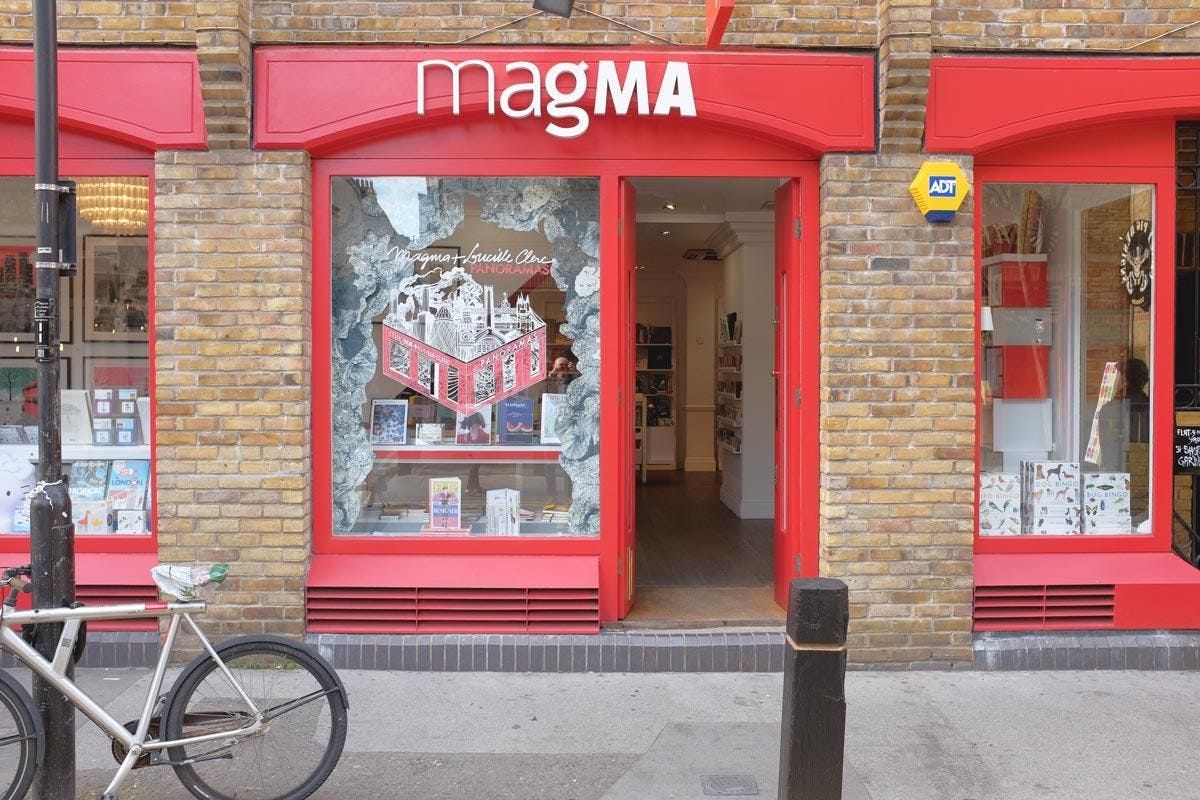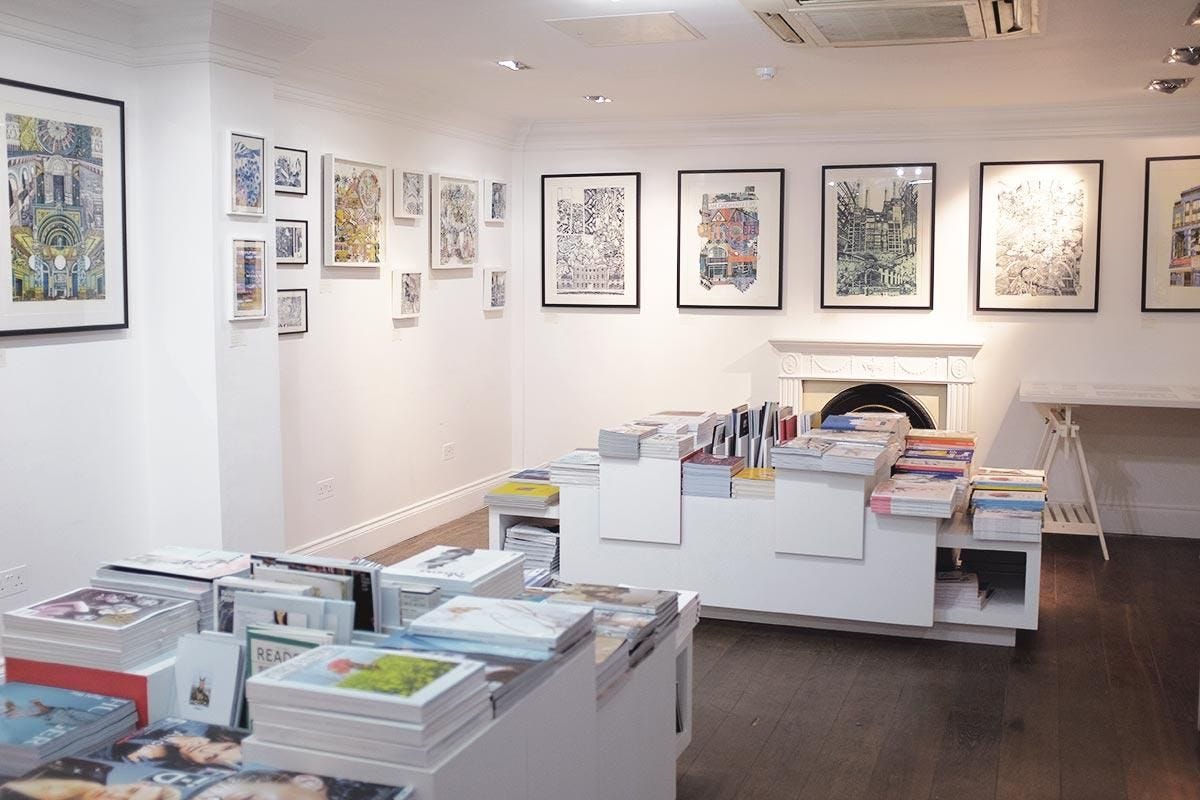Sunday Scoop is a weekly dose of creative inspiration, cultural discoveries, and personal reflections that are shaping my creative journey 💚
👋 Hiya!
This week's letter is written from London. I got lucky escaping New York's nasty heatwave for a few days. For this short trip, I tried my best not to overwhelm myself with plans, but there are just so many fun shops and galleries here that it was hard to resist...and also hard to pick just 3 things for Sunday Scoop.
1️⃣ Why physical spaces for strange, beautiful publications are worth protecting — Magma
2️⃣ A flower exhibit that reveals how beauty and symbolism shape how we process the world — Saatchi Gallery
3️⃣ How personal struggle can become a creative fuel — Charles Dickens Museum
📌 Pinned IRL : Magma
There are a few places I personally love so much that I return every time I'm in London. Magma is one of them. I found Magma when I started collecting independent magazines. At the time, I was surprised by how many more independent publications were available in London compared to New York. It feels like there’s still a strong indie magazine scene in Europe — new titles are published regularly, and you can actually find a wide variety stocked in shops. In contrast, my favorite bookstore in NYC, McNally Jackson, does carry some indie mags, but the selection is much more limited. So over the years, I've discovered magazines like Backstage Talks, Pleasant Place, Desired Landscapes through places like Magma.
Magma isn’t only about magazines. Magma curates books and goods related to art, design, and culture. The front section is filled with creative tools and goodies like tarot and oracle decks, puzzles, card sets. The back has a mix of art, design, and culture books alongside home goods. And downstairs is where I stay the longest — a full floor of magazines, carefully curated from around the world.
This time, I bought NOMA in Kyoto, Fukt (Berlin-based drawing magazine), and Never Too Small (Aussie magazine about small space design).
I still get excited holding these in my hands. It’s not just about the design or topics — it’s the reminder that people around the world are consistently publishing thoughtful, strange, beautiful work. And that there’s still space for slow, tangible media.
If you’re into magazines, MagCulture and STACK are also worth checking out. But if you’re ever in London, Magma is the one I’d point you to first.
📍MAGMA: 29 Short's Gardens, London
👀 What Caught My Eyes: Saatchi Gallery - FLOWERS
I got lucky with this exhibit because it reopened for extended summer season. The topic felt broad at first (how many ways can you show flowers?), but the curation was surprisingly rich and layered.
The exhibit is divided into nine sections, each exploring a different lens — from science and fashion to film, literature, and symbolism. Instead of feeling decorative, the works revealed how flowers have long carried emotional, political, and cultural meaning.
My favorite was the first room "ROOTS," showing how artists were inspired by flowers throughout history—Renaissance to Impressionism, Art Nouveau to contemporary. It wasn’t just about pretty depictions of nature; it explored how flowers carried symbolic meaning across time. I especially loved seeing William Morris’s patterned wallpapers alongside works by Mucha and Monet — each with their own way of turning nature into visual language.
One of the most unexpected parts was the “Music, Film, and Literature” section. There were film posters, vinyl records, and examples of how flowers shaped visual language beyond fine art. One piece that stayed with me was the posters for The Zone of Interest. Flowers were used to depict a beautiful garden next to a Holocaust death camp — a haunting symbol of the dissonance between beauty and atrocity.
I’ve always loved flowers, but usually just in passing in photos, in gardens, in wrapping paper. This exhibit made me think about why they’re so present in our lives. Why they show up in grief and celebration, in propaganda and pop culture. I left with a few small books on floriography and flower color symbolism — of course I did.
🔍 Field Trip: Charles Dickens Museum
I read Dickens in school but never really knew him as a person. This museum was a great peek into his life!
Fun facts I learned:
Difficult childhood—forced to work at age 12 in a factory because his dad went to prison. He stayed extremely anxious about money his entire life, even after success.
He was basically the Victorian era's INFLUENCER. Made his separation from his wife public through his own magazine and distributed personal statements to friends and press. (Quite narcissistic 😂) But they had ten children together first…
His sister-in-law Mary died in his arms at 17, which deeply affected him and inspired characters in many novels.
He loved performing dramatic public readings of his own work—almost like one-person theatrical shows. Super popular but took a serious toll on his health (he designed his own reading desk for performance).
Walking through the house, listening to narration from his great-great-great-grandson, you start to see the pattern: his personal life wasn’t separate from his writing — it was fuel for it — like Oliver Twist's workhouse struggles basically replicated Dickens's own childhood.
What I took away was that sometimes your most difficult experiences become the most durable material, especially when paired with a relentless drive to make sense of the world.
✨ Until Next Sunday…
There’s something about being in a different environment that sharpens your senses. Travel has a way of shifting your perspective — making familiar things feel new, and small details feel worth noticing. Sometimes it’s not about seeing more, but about seeing differently. Whether you’re near or far this week, I hope something ordinary catches your eye in an unexpected way.
If this Sunday Scoop resonated with you, the best compliment would be to share it with one person who might enjoy this or restack it for others to discover 💚














